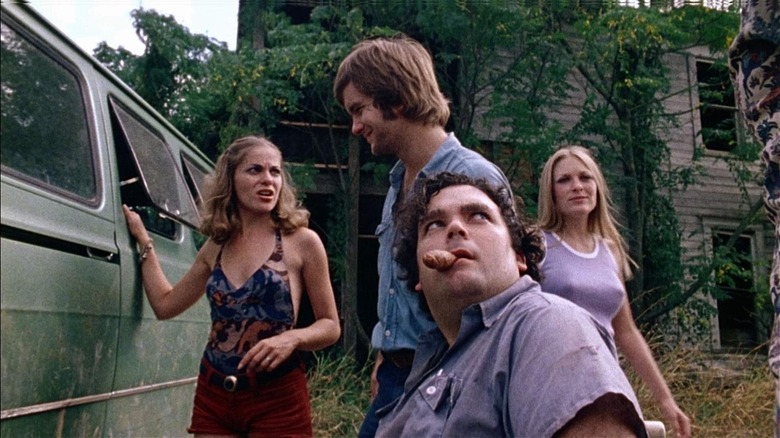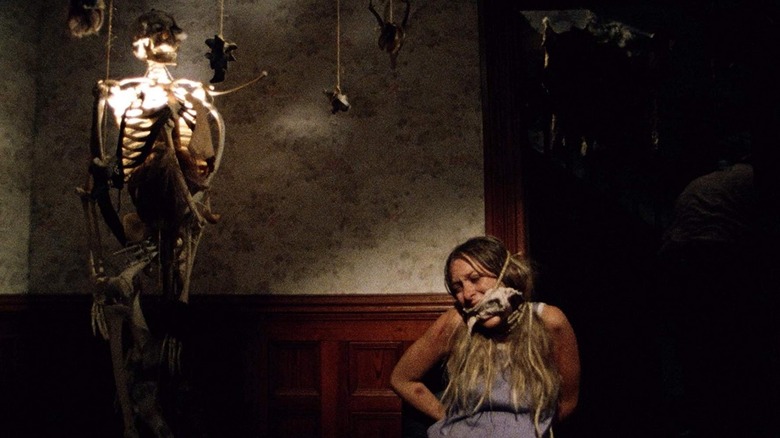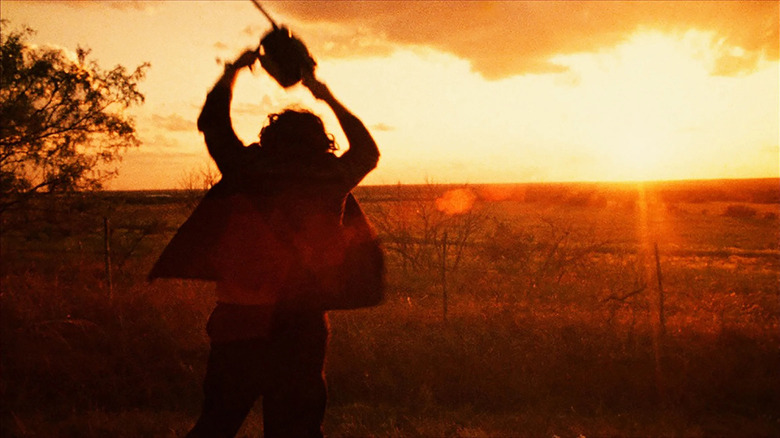
Almost 50 years on, there are few films that immerse the viewer so viscerally in terror as effectively as "The Texas Chain Saw Massacre." It's not so much what Tobe Hooper shows, because the film is nowhere near as gory as its title or reputation suggests. It is more the sweltering atmosphere of all-encompassing insanity that frays the nerves.
Loosely based on the ghoulish crimes of murderer and graverobber Ed Gein, the film hit theaters in the wake of the Watergate scandal and the disastrous U.S. involvement in Vietnam. In response to the grim political landscape at the time, Hooper wanted his film to reflect the general cynicism many people felt. Unlike the vampires and ancient mummies of the Hammer horror movies he loved in his youth, he realized that man was the real monster. In the hulking figure of Leatherface, all Hooper had to do was give his villain a mask made from human skin and a chainsaw to change the direction of horror cinema, influencing the wave of slashers with masked maniacs like Jason Vorhees and Michael Myers.
To drive Hooper's point home, realism and a contemporary setting were key to the film's raw power. Horror movies were already moving towards increased realism since Romero's groundbreaking "Night of the Living Dead" documented a zombie invasion, while William Friedkin took an almost documentary-like approach to observe the central ritual in "The Exorcist." Meanwhile, the old-school horror of Hammer Studios was on its last legs in the '70s; a few months before "Chainsaw" was released, "The Legend of the Seven Golden Vampires" nakedly tried to cash in on the kung-fu phenomenon. Even that shameless nod to modernity could stop the studio's sad shuffle toward its own crypt. Hooper reinvented horror as Hammer was on its last legs.
Tobe Hooper

"The Texas Chain Saw Massacre" follows a simple premise that is now a clichéd horror trope: A van full of young folk head out to an old house in the middle of nowhere, ignoring the dire warnings of sinister locals, and find themselves preyed upon by evil that lurks there. Hooper's film stands out with the all-pervading sense of madness and menace, permeating every frame; from the opening shot of a decomposed corpse arranged in a depraved pose by grave robbers, we know this isn't going to have a happy ending.
Hooper takes his time with the set-up, building tension as the kids encounter drunken rednecks, half-crazed hitchhikers, and a surly gas station owner who has no gas. They're still in the normal world at this point, and already it is vaguely sinister. When they later stumble on the home of a family of cannibals, the danger is apparent; decorated with crude ornaments fashioned from skeletons, this is a deranged place.
When Leatherface (Gunnar Hansen) bursts onto the scene and the killing starts, it is quick and brutal, and the film is carefully edited so we think we see more than is actually on screen. Just like the shower scene in "Psycho" doesn't actually show the killer's knife penetrating the flesh, neither do we see a meathook rip into one victim's back or watch Leatherface dismember a corpse. But it certainly feels like we do.
Once all the kids are dead apart from Sally (Marilyn Burns), the final act is a nauseating descent into abject terror, centered around the most hellish dinner table scene ever filmed. Sally's relentless shrieking becomes the soundtrack of the film as she is abused, tortured, and narrowly escapes. She might get away at the end, but you can tell she'll never be okay again.
'I Couldn't Get As Affected By Those Movies Anymore'

"The Texas Chain Saw Massacre" was a grueling shoot for the cast and crew, working in temperatures exceeding 100 degrees in a house decorated with animal bones and blood from a local slaughterhouse. It's a movie you can almost smell, so just imagine what it must have been like on set. It was grim for everyone involved, and that was exactly the way Hooper wanted it to obtain genuine bad vibes for the film's baleful atmosphere. His goal was clear (via Flashback Files):
"Psychologically, the idea behind 'The Texas Chainsaw Massacre' was that the movie would enter your mind the way music does. Sounds and music, more so than visual storytelling, can open up a larger aperture to receive emotions of what you are experiencing."
Hooper certainly succeeded. Without resorting to the kind of cheap jump scares that would become a staple of the slasher genre, the film leaves you with a bone-deep sense of revulsion and horror that lingers long after the credits roll. Needless to say, a director like Hooper with a clear philosophy behind what he was trying to achieve knew it couldn't be done the old-school way:
"As a kid I used to love those [Hammer] movies. The gothic horror stories... But at a certain point I became aware of a separation. I couldn't get as affected by those movies anymore. It was like this: could I put myself in that situation on the screen and react? That seemed a lot easier with contemporary horror movies."
I can't imagine anyone feeling scared watching a Hammer horror after experiencing "The Texas Chainsaw Massacre." Hammer movies are cozy entertainment, while Hooper's film is specifically designed to freak you out and f*** you up. In that sense, it is horror distilled to its purest form.
Read this next: The 95 Best Horror Movies Ever
The post Tobe Hooper Wanted To Push Horror Beyond The Limits Of Old-School Hammer Films appeared first on /Film.
0 Comments